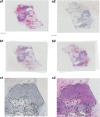Automated quantitative analysis of Ki-67 staining and HE images recognition and registration based on whole tissue sections in breast carcinoma
- PMID: 32471471
- PMCID: PMC7257511
- DOI: 10.1186/s13000-020-00957-5
Automated quantitative analysis of Ki-67 staining and HE images recognition and registration based on whole tissue sections in breast carcinoma
Abstract
Background: The scoring of Ki-67 is highly relevant for the diagnosis, classification, prognosis, and treatment in breast invasive ductal carcinoma (IDC). Traditional scoring method of Ki-67 staining followed by manual counting, is time-consumption and inter-/intra observer variability, which may limit its clinical value. Although more and more algorithms and individual platforms have been developed for the assessment of Ki-67 stained images to improve its accuracy level, most of them lack of accurate registration of immunohistochemical (IHC) images and their matched hematoxylin-eosin (HE) images, or did not accurately labelled each positive and negative cell with Ki-67 staining based on whole tissue sections (WTS). In view of this, we introduce an accurate image registration method and an automatic identification and counting software of Ki-67 based on WTS by deep learning.
Methods: We marked 1017 breast IDC whole slide imaging (WSI), established a research workflow based on the (i) identification of IDC area, (ii) registration of HE and IHC slides from the same anatomical region, and (iii) counting of positive Ki-67 staining.
Results: The accuracy, sensitivity, and specificity levels of identifying breast IDC regions were 89.44, 85.05, and 95.23%, respectively, and the contiguous HE and Ki-67 stained slides perfectly registered. We counted and labelled each cell of 10 Ki-67 slides as standard for testing on WTS, the accuracy by automatic calculation of Ki-67 positive rate in attained IDC was 90.2%. In the human-machine competition of Ki-67 scoring, the average time of 1 slide was 2.3 min with 1 GPU by using this software, and the accuracy was 99.4%, which was over 90% of the results provided by participating doctors.
Conclusions: Our study demonstrates the enormous potential of automated quantitative analysis of Ki-67 staining and HE images recognition and registration based on WTS, and the automated scoring of Ki67 can thus successfully address issues of consistency, reproducibility and accuracy. We will provide those labelled images as an open-free platform for researchers to assess the performance of computer algorithms for automated Ki-67 scoring on IHC stained slides.
Keywords: Automatic recognition; Breast invasive ductal carcinoma; Convolutional neural network; Ki-67 counting; Whole tissue sections.
Conflict of interest statement
The authors declare no competing financial interests.
Figures





Similar articles
-
Multi-institutional comparison of whole slide digital imaging and optical microscopy for interpretation of hematoxylin-eosin-stained breast tissue sections.Arch Pathol Lab Med. 2013 Dec;137(12):1733-9. doi: 10.5858/arpa.2012-0437-OA. Epub 2013 Aug 15. Arch Pathol Lab Med. 2013. PMID: 23947655
-
Cytokeratin-Supervised Deep Learning for Automatic Recognition of Epithelial Cells in Breast Cancers Stained for ER, PR, and Ki-67.IEEE Trans Med Imaging. 2020 Feb;39(2):534-542. doi: 10.1109/TMI.2019.2933656. Epub 2019 Aug 7. IEEE Trans Med Imaging. 2020. PMID: 31398111
-
Impact of tissue sampling on accuracy of Ki67 immunohistochemistry evaluation in breast cancer.Diagn Pathol. 2016 Aug 30;11(1):82. doi: 10.1186/s13000-016-0525-z. Diagn Pathol. 2016. PMID: 27576949 Free PMC article.
-
Deep computational pathology in breast cancer.Semin Cancer Biol. 2021 Jul;72:226-237. doi: 10.1016/j.semcancer.2020.08.006. Epub 2020 Aug 17. Semin Cancer Biol. 2021. PMID: 32818626 Review.
-
A semi-automated microscopic image analysis method for scoring Ki-67 nuclear immunostaining.Braz J Med Biol Res. 2023 Nov 13;56:e12922. doi: 10.1590/1414-431X2023e12922. eCollection 2023. Braz J Med Biol Res. 2023. PMID: 37970922 Free PMC article. Review.
Cited by
-
Visual Counting and Automated Image-analytic Assessment of Ki-67 and their Prognostic Value in Synovial Sarcoma.Cancer Diagn Progn. 2022 Jan 3;2(1):7-14. doi: 10.21873/cdp.10070. eCollection 2022 Jan-Feb. Cancer Diagn Progn. 2022. PMID: 35400010 Free PMC article.
-
The Evolution of Ki-67 and Breast Carcinoma: Past Observations, Present Directions, and Future Considerations.Cancers (Basel). 2023 Jan 28;15(3):808. doi: 10.3390/cancers15030808. Cancers (Basel). 2023. PMID: 36765765 Free PMC article. Review.
-
[Application Test of the AI-Automatic Diagnostic System for Ki-67 in Breast Cancer].Sichuan Da Xue Xue Bao Yi Xue Ban. 2021 Jul;52(4):693-697. doi: 10.12182/20210460202. Sichuan Da Xue Xue Bao Yi Xue Ban. 2021. PMID: 34323051 Free PMC article. Chinese.
-
Beyond 2D cell cultures: how 3D models are changing the in vitro study of ovarian cancer and how to make the most of them.PeerJ. 2024 Aug 29;12:e17603. doi: 10.7717/peerj.17603. eCollection 2024. PeerJ. 2024. PMID: 39221267 Free PMC article. Review.
-
Use of Novel Open-Source Deep Learning Platform for Quantification of Ki-67 in Neuroendocrine Tumors - Analytical Validation.Int J Gen Med. 2023 Dec 4;16:5665-5673. doi: 10.2147/IJGM.S443952. eCollection 2023. Int J Gen Med. 2023. PMID: 38077478 Free PMC article.
References
MeSH terms
Substances
Grants and funding
LinkOut - more resources
Full Text Sources
Medical

